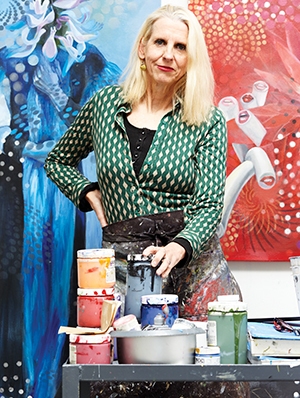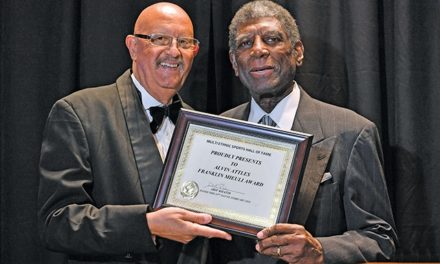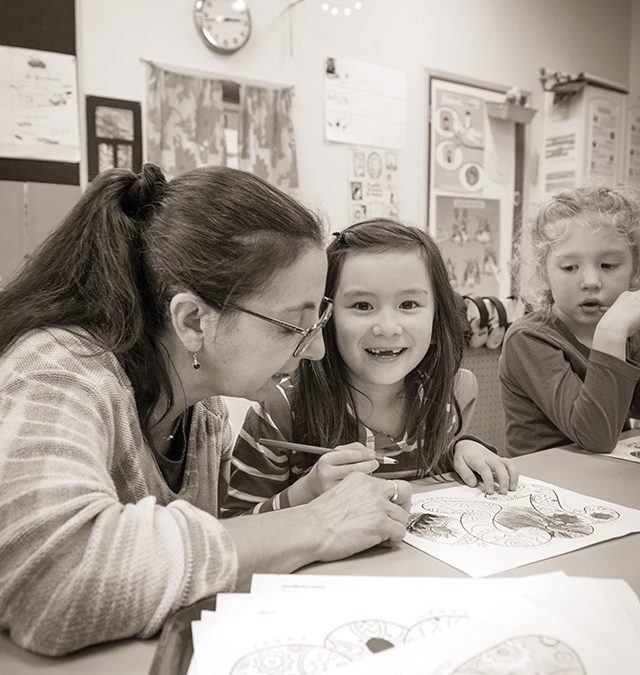The work of the East Bay multimedia artist pops up in public and private spaces and the most unusual places, like San Francisco taxicabs.
Not everyone has time to linger in an art gallery, but the creations of Johanna Poethig are all around us, in private spaces and public places. As a multimedia artist, teacher, collaborator, and agent of sociopolitical inquiry, Poethig displays her work in such vastly different locations as parks, library building exteriors, a market in Tblisi, Georgia — where tire sculptures were transformed into “totems” — and on the tops of taxicabs in San Francisco as public art.
For Poethig, there seems to be no boundaries, but there are walls — walls, and other platforms, around the globe that tell stories of social inequity, feminism, and the beauty of place. “I am interested in working from conceptual ideas that express the times I live in and my position in it,” Poethig said. She includes among her creative influences indigenous artists of the Ifugao and Maranao regions of the Philippines, experimental musicians and composers, and the Mexican Mural movement.
Poethig grew up in the Philippines, where she learned the predictive practices of being a manghuhula, or soothsayer, which also influences her work as an artist.
Leaving the Philippines for Chicago at age 15, she eventually arrived in California to attend college at UC Santa Cruz where she received a BFA in 1980. She moved to the Bay Area later to complete an MFA at Mills College in Oakland. These days, she spends afternoons in an art studio behind her home in the North Oakland. Poethig is represented by Mercury 20 Gallery, where her most recent exhibition was Phyllotaxis and Parastichy in a Time of Love and War, a solo show of paintings and prints that experimented visually with the mathematical algorithms of plants.
A frequent lecturer, she recently sat on a panel discussion on “Centering Legacies of Resistance: Asian American Visual Culture Strategies” at the Asian American Studies Association in Portland. Next up, she will participate in “50 Shades of Kayumanggi: Filipino Americans and the Archetypical Imagination” at Dominican University of California’s San Marco Gallery in San Rafael June 8-Sept. 8.
“I’m inspired by individual, cultural, and collective art movements that help our society evolve through creative exchanges and suspension of hierarchies so that we can enjoy our time together on earth imagining, making, and participating in art that expands our thinking and links us across time and place,” she said. Poethig added that she is humbled by the bravery of artists who are in real immediate danger yet continue to do their work.
As professor of painting and public art at CSU Monterey Bay, she mentors students on the creation of political art murals. In partnership with the Monterey Art Council, her students created large-scale murals in Pajaro. Through the creation of public art, Poethig hopes to inspire viewers to take interest in form, to be intrigued by the content, and allow for an everyday attachment to a landmark to become part of life and memory with curiosity, amusement, and pleasure.
One example in East Bay purview: She co-created a mural in collaboration with Berkeley artist Mildred Howard at the Youth Uprising Center on MacArthur Boulevard for the organization whose aim is “to transform East Oakland into a healthy and economically robust community by developing the leadership of youth and young adults.” Keep your eyes open in your wanderings about town. Poethig is currently the lead artist on a team of four — with Mildred Howard, Peter Richards and Joyce Hsu — creating public art for the AC Transit’s Bus Rapid Transit 9-mile corridor at 34 bus shelters from Oakland to San Francisco.
Visit her website for more information: JohannaPoethig.com
















